Introduction
Dear students:
This manual has been developed to assist you in complying with the formal aspects required for the presentation of the final project.
The main objective of the formal aspects is to maintain a standard in the structure and presentation of the final projects. By defining the formal aspects, it is possible that all final projects have the same structure and appearance, facilitating access to information, correction, and evaluation by FP directors.
Now, imagine that standards did not exist, giving them the possibility to develop their scientific productions in the way they wish, generating a variety of documents with different typologies of methods, formats, and organizations of ideas. In this way, what would be the parameters used to legitimize and evaluate this variety of formats used? It would be impossible to evaluate them within the same parameters, which would also hinder the circulation of the knowledge generated within society.
Formal aspects are important and are evaluated by the Evaluation Committee.
Do not leave these corrections until the end. Take care of the formal aspects from the beginning, mainly to keep the text aesthetically organized and to make it easier for your FP Director to better understand your project.
INITIAL CONSIDERATIONS
The formal aspects that we will deal with in this document have been established by the university, which means that it is its own standard, and although some characteristics may coincide, it does not follow the rules of presentation of other recognized standards, such as APA, Vancouver, ABNT, Chicago, etc.
These standards have been established to standardize the presentation of texts regardless of the area of study programs. It is important to note that we are dealing only with formal characteristics. In this document, we will not deal with the presentation of bibliographic references. To do so, consult: APA or Vancouver guidelines.
1. FORMAL ASPECTS OF THE TEXT
The Final Project (FP) is a formal document that must be prepared and written according to the following academic requirements:
1.1. Font, font size, and color
Except for chapter headings, in general, the font should be Arial, black color, and size 11.

1.2. Page size
The page should be A4 size.
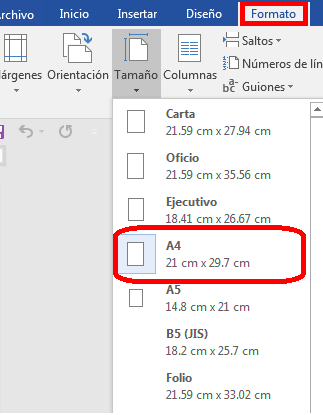
1.3. Margins
The top and left margins shall be 3 points, while the bottom and right margins shall be 2.5 points.
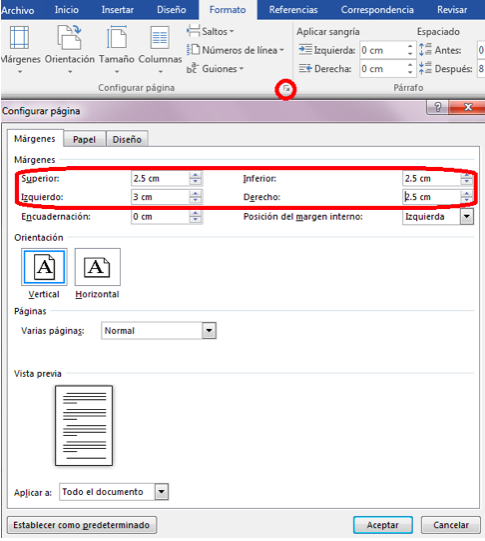
1.4. Paragraph
1.4.1. Line spacing, alignment, indentation
Allparagraphs of text in the body of the project must comply with the following characteristics:
- Alignment: Justified
- Scheme level: Independent text
- Indentation: left and right – 0 cm. Special: (none)
- Spacing: leading and trailing – 0 pt
- 1.5 line spacing
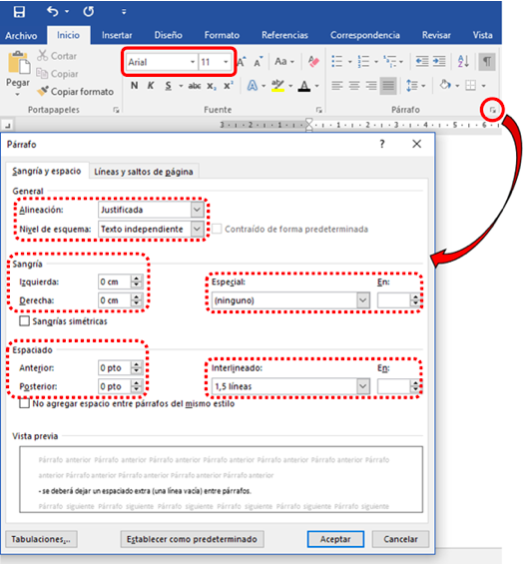
An empty line should be left between paragraphs. A very useful tool in Word is the “Show all”, button, shown in the figure below, which allows you to see where the empty lines are and which will help you to confirm this extra spacing required by the formal characteristics of the text:
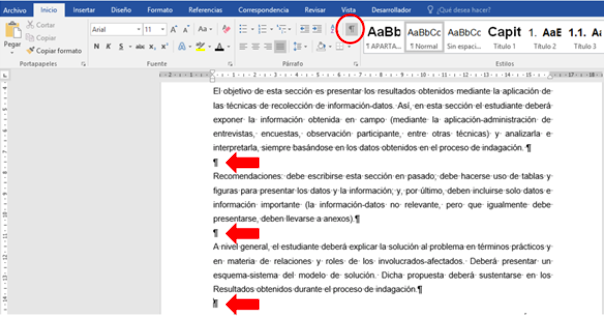
1.4.2. Numbering of chapter titles
In order to facilitate the ordering of the contents of the FP, the different divisions and subdivisions of the document should be numbered, as shown in the Official Template of the FP Report:
- Only the chapters and sections included in the Theoretical Framework and Methodology should be numbered.
- In the subchapters (level 2), the number of the level 1 chapter in which they are located must be given first, followed by a second number that will mark their correlative order
- In the sections (level 3), the number of the level 1 chapter in which they are located must be given first, followed by the number of the subchapter (level 2), and then by the number that marks their correlative order.
- In the subsections (level 4), the number of the level 1 chapter in which they are located must be given first, followed by the number of the subchapter (level 2), followed by the number of the section (level 3), and then by the number that marks their correlative order.
- The numbers are separated by inserting a period between the digits.
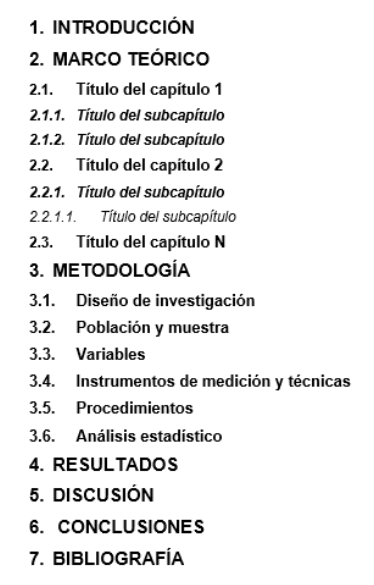
1.4.3. Presentation of the FP chapter titles
- Chapter headings (level 1) should be presented in Arial font, size 14, bold with capital letters.
- Subchapter headings (level 2) should be presented in Arial font, size 12, bold, and in sentence format, i.e., only the first word begins with a capital letter.
- Section headings (level 3) should be presented in Arial font, size 11, bold, and italic in sentence format, i.e., only the first word begins with a capital letter.
- Subsection headings (level 4) should be presented in Arial font, size 11, in italics, and in sentence format, i.e., only the first word begins with a capital letter.
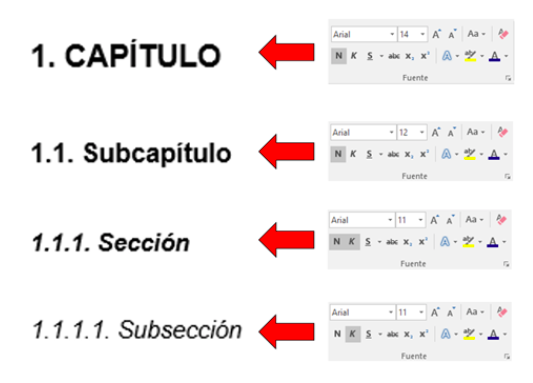
It must be verified that there is no fifth level subdivision, for example, 1.1.1.1.1. This level of subdivision can be used; however, it is not numbered and is not presented in the index. In the body of the project, this title will be presented without numbering and may be highlighted using underlining, bullets/hyphens, or letters. For example:
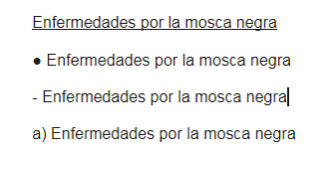
It is important to emphasize that establishing many subdivisions in the chapters may even make it difficult to understand the text and not leave it organized as the student imagines it to be. Use these subdivision levels with great caution and check if it is necessary to use them. If you prefer to use letters, make sure there are 2 or more headings so that there is a logical sequence with the letters. It would not be right to use letters with only one heading (a) and not have the (b).
Important:
- In the contents of the FP, the chapters start on a new page.
- If the title of the chapter/subchapter/section/subsection is at the bottom of the page and its first paragraph on the next page, then the student should include the title on the next page.
1.5. Page numbering
Page numbering should start at the Introduction and end at the last page of the project (both included), i.e., up to the last page of the appendices.
Pages are numbered with Arabic numerals, starting with 1, followed by 2, 3, 4, etc. This numbering is in Arial font, size 12, black, and should be placed at the bottom of the page, aligned to the right.
Page numbers should not be included on the pages preceding the Introduction, that is, on the pages from the title page to the abstract (both included).
1.6. Presentation and numbering of figures and tables
All tables and figures included to complement the explanations in the written text must be accompanied by a numbered heading and the corresponding bibliographic citation.
Some presentation issues:
- Do not use any other type of designation such as “tables” or similar for tables.
- Figures are understood to be images, maps, photographs, graphs, or any other form of graphic representation.
- All tables and figures presented in the body of the project should be mentioned in the text.
- The titles of tables and figures should be presented according to the guidelines of the corresponding citation standards: APA or Vancouver guidelines..
- A table or figure should not be split between two pages.
- If the table or figure is located at the bottom of the page, its heading can never be placed on the next page. If this situation occurs, consider two possibilities:
- Reduce the size of the table or figure so that its heading returns to the previous page and is again attached to the figure;
- or include the figure on the next page.
- Tables and figures should not exceed the established margins. If they are very large, consider changing the orientation of the page to “horizontal.” It will also be possible to reduce the font size, as long as its readability is not compromised.
- It is important to take care of the aesthetics of tables and figures so that they are understandable to the reader.
Regarding numbering:
- Numbering should be in Arabic numerals and should consist of a digit corresponding to its appearance in the text, starting with Table 1 or Figure 1 for the first table or figure in the project, Table 2 or Figure 2 for the second table or figure in the project, and so on.
- Tables and figures are numbered independently. For example, in the same project, there may be Table 3 and Figure 3: Table 3 will be the third table of the project and Figure 3 will be the third figure of the same project.
Regarding the inclusion of bibliographic source of tables and figures:
- Projects written in accordance with the Vancouver guidelines must include the source of the table or figure followed by the title with the number of the corresponding bibliographic citation in parentheses (see the Vancouver Guidelines for more details). When the table or figure is of own elaboration, the source is omitted.
- Papers written according to APA guidelines should take into account that the corresponding notes (with their own numbering) should be added below the table or figure. The source of the table or figure should also be cited at the bottom (see APA guidelines for more details).
- The bibliographic sources from which the student obtained the information should be presented. It is a very common mistake to present the source as “Own elaboration” (or “Own authorship”) because the student has personally elaborated the table or figure in the FP with information obtained from another source. Attention!
- It is not correct to present tables obtained from other bibliographic sources in image format.
2. COVER
| It is mandatory to respect the original format and structure of these covers, as well as to complete all sections. This section describes the formatting requirements to be met by the cover page components. Remember that in the Development manual of the FP Report Template the data to be included in the cover page components are detailed. |
The following are the formal aspects that each section of the cover page must comply with:
a) Name of the academic area of the study program
It is presented in Arial font, size 14, bold, in uppercase letters, black, and centered.
b) Title of the FP:
It is presented in Arial font, size 12, bold, in lowercase letters (remember that the first letter of the words must be capitalized), black, and centered.
c) Study program’s name:
It is presented in Arial font, size 12, bold, in lowercase letters (remember that the first letter of the words must be capitalized), black, and centered.
d) Student’s full name:
It is presented in Arial font, size 12, bold, in lowercase letters (remember that the first letter of the words must be capitalized), black, and centered.
e) Student login:
It is presented in Arial font, size 12, bold, in uppercase letters, black, and centered.
f) FP Director’s name:
It is presented in Arial font, size 12, bold, in lowercase letters (remember that the first letter of the words must be capitalized), black, and centered.
g) City and country of the student:
It is presented in Arial font, size 12, bold, in uppercase letters, black, and centered.
h) FP year of completion:
It is presented in Arial font, size 12, bold, black, and centered.
3. DOCUMENT LENGTH
The length of the paper will depend on the degree of the program:
- Specialization: between 30 and 50 pages
- Master’s degree: between 40 and 80 pages.
- Bachelor: between 40 and 80 pages.
Important this defined length refers to the pages between the “Introduction” and the “Bibliographical references.” Therefore, the pages preceding the “Introduction” (title page, acknowledgments, etc.) and the “Annexes” do not count towards the final length of the FP.
It is important to note that the number of pages should be more or less equally distributed among the chapters. In other words, it is not possible to present chapter 1 with only two pages and chapter 2 with 15 pages.
The quality of the FP is not determined by how extensive the FP’s memory is but by the relevance of its research. Remember: “if a good thing is brief, it is twice as good.”. |
4. EDITING AND WRITING STYLE
It is indisputable that each author has his or her own style of writing, but this does not exclude that the text should follow a style appropriate to the academic context. Within the freedom of each author, a series of tips are provided below to help you read the text better. In any case, the two basic rules governing any writing style are consistency and simplicity.
- Maintain a consistent style throughout the text.
- Write short sentences. A “telegraphic” but clear style is preferable to a convoluted and confusing style. A clear idea can be expressed in a short and simple sentence. It is important to emphasize that a sentence ends with a “period” or a “semicolon” but not with a “comma” only.
- Make sure that all your sentences contain a verb (conjugated). When writing long sentences, you may forget to use a main verb. A sentence without a conjugated verb is an incomplete sentence.
- Try to construct your sentences in the most classical order (subject-verb-object). Making original variations often leads to tangles in the wording.
- Avoid excessive subordinate clauses. It is very common to write long sentences with several subordinate clauses. In these cases, it is good to ask yourself what the main idea is and give it the form of a short and complete sentence. Subordinate sentences can then be transformed into complementary but independent, short, and complete sentences. In this way, a long and confusing sentence is transformed into a paragraph of short and coordinated sentences.
- It is advisable to moderate the use of suspension points, interjections between dashes, and parentheses.
- Avoid one-sentence paragraphs. Every paragraph must contain a main sentence and, together with it, supporting sentences (argumentative, explanatory, exemplifying, etc.). Make the paragraph the drafting unit.
- Opt for collective names rather than gender splitting whenever possible (“the student body” or “the students”, rather than “the male students and female students”).
- If possible, write in the affirmative: “remember that” is better than “don’t forget that.”
- Opt for simplicity. For example, avoid “in which,” “that which,” or “of which” (and derivations) when “which” can be used; opt for simple forms of verbs rather than periphrastic forms (“maintain them” rather than “perform them a maintenance”); opt for adverbs rather than adverbial locutions (“yes” instead of “on the assumption that”).
- It is recommended to present the results with confidence: avoid the use of potential (could…), avoid the abuse of “etc.” (it is better to give complete lists if necessary), or avoid verbs related to assumptions or judgments (we believe, maybe it would be…).
- When numerical data are provided (75% of Australians…), they must be accompanied by the corresponding source.
- When reference is made to external mentions or expressions, they must be accompanied by the corresponding source. Therefore, it is better to avoid expressions such as “lately, it is believed that…”
- Possible ambiguities and unclear concepts must be eliminated.
- Use hyphens, letters (a,b,c…), or numbers (1,2,3…) for concept lists if you need to enter them.
In relation to the verb tense:
- The text should be written in the third person. For example, “I made a survey” is not well expressed, the correct is: “a survey has been conducted.”
- The summary is written in the past tense.
- The introduction, statement, and theoretical framework are written in the present tense since they are aspects that are valid to date and remain valid over time.
- The methodological design and procedures are written in the past tense since they represent actions that have already been carried out.
- The results are written in the past tense since they were obtained before writing the FP.
- In discussion:
- It is written in the present tense when discussing and commenting on research by other authors since it is current knowledge that is used as a reference.
- When the results obtained in the research itself are discussed, they are written in the past tense.
In relation to the verb tense:
- The text should be written in the third person. For example, “I made a survey” is not well expressed, the correct is: “a survey has been conducted.”
- The summary is written in the past tense.
- The introduction, statement, and theoretical framework are written in the present tense since they are aspects that are valid to date and remain valid over time.
- The methodological design and procedures are written in the past tense since they represent actions that have already been carried out.
- The results are written in the past tense since they were obtained before writing the FP.
- In discussion:
- It is written in the present tense when discussing and commenting on research by other authors since it is current knowledge that is used as a reference.
- When the results obtained in the research itself are discussed, they are written in the past tense.
5.MEASUREMENT UNITS
Abbreviations of units of measurement will follow the rules of the International System of Units (SI). Below is a table with the most frequent quantities and their respective abbreviations. The full SI document can be downloaded here.
| Magnitude | Name | Abbreviation |
|---|---|---|
| Length | centimeter | cm |
| Length | meter | m |
| Length | kilometer | km |
| Mass | kilogram | kg |
| Mass | ton | t |
| Time | second | s |
| Time | hour | h |
| Time | minute | min |
| Time | day | d |
| Volume | liter | l o L |
| Volume | milliliter | ml |